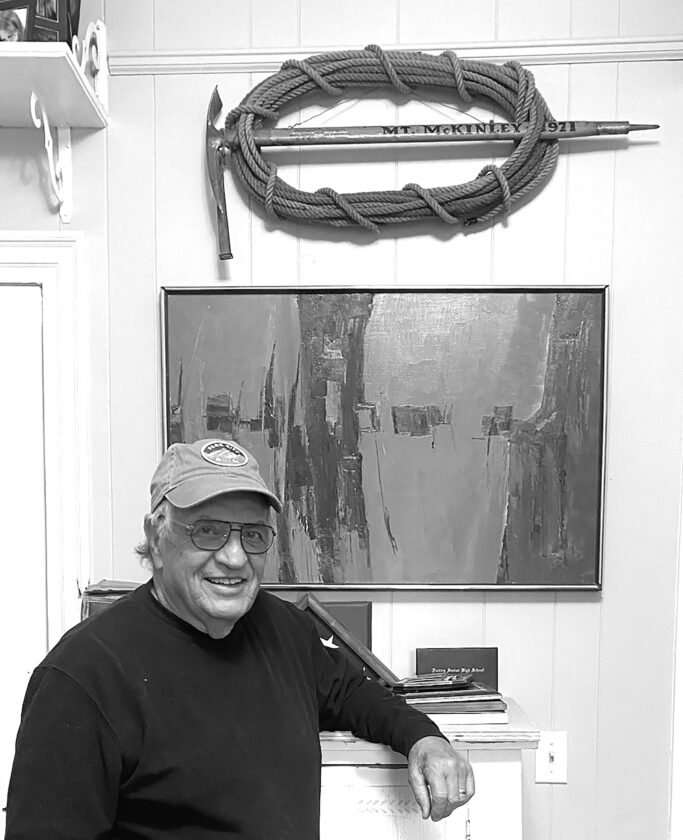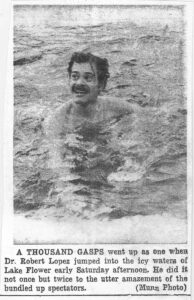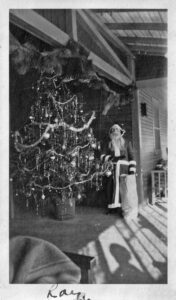After 54 years some things don’t change

The ice axe and Goldline. (Provided photo — Jack Drury)
About a year and a half ago, I got a text along with a photo from former student and friend Mark Simon. I didn’t recognize the person in the photo, but the vintage Goldline rope and the ice axe on the wall saying Mount McKinley 1971 were intriguing, because it was the same year I climbed the mountain.
Mark texted, “From the stories you told me about your climb, I think this guy was on the same expedition.”
I said, “What’s his name?”
He said, “Scott O’Brien.”
I said, “Ah, from Findlay, Ohio.”
Mark had stumbled upon one of my Denali climbing colleagues, now living in, of all places, Watertown. I made a note of the information and promptly forgot about it.
I don’t know what triggered me to look at Scott’s contact information after sitting on it for a year and a half. Perhaps it’s a reflection of my old age and nostalgia that reminds me how fortunate I’ve been to have met so many fascinating people and to have had so many remarkable adventures. Whatever the trigger, last Wednesday I found Scott’s cell phone number and sent off a quick text suggesting we get together.
I then went on with my day, thinking, “It will be cool if he responds, but if he doesn’t, that’s okay too. Nothing ventured, nothing gained.” I ran errands, stopped by to chat with Mr. InSeide Dope, split some wood and got home around 12:30 for some well-earned lunch. I soon got a response from Scott, saying that he looked forward to getting together. We decided to meet at the Watertown Longhorn Steak House on Friday at 1 p.m.
I reread my Denali journal, put some of the photos from the climb on my phone and then reached out to my friend Dave Iuppa, the only other expedition member I’ve been in touch with over the last decade. Ironically, he’d been Scott’s tent partner for a good portion of the expedition.
Friday, a little after 1:00, Phyliss and I walked into the steak house and saw a couple our age sitting at the bar. Sure enough, it was Scott and his wife Jessica. I can’t say I would have recognized him, nor do I think he would have recognized me: The last time we saw each other, I was twenty-two and he was twenty-six. After introductions, we sat down for some lunch and started catching up.
For a couple of hours, we shared stories about Denali and our pre- and post-Denali lives. As we prepared to leave, Scott handed me a thumb drive of his photos from the trip. I showed him the photos I had put on my phone and promised to send them all to him. We decided to get together again soon. We hadn’t seen each other in over 50 years, but it was obvious that we had a fellowship based on our common experience.
So, what creates a bond that lasts over fifty years? After all, we were just a random collection of twenty-somethings who only had in common a generous love of the outdoors and adventure.
The bond started that June in Anchorage, the morning we met and spent the day packing food, getting outfitted and preparing for our eight-hour train ride to Denali National Park. But I think it really started as we crossed the McKinley River on the twenty-mile trek from Wonder Lake to the Muldrow Glacier. We moved slowly and deliberately through the mosquito-infested lowlands of kames and kettles with our eye on the 20,310-foot peak enveloped in clouds.
I’d hiked with heavy packs before, but I’d never hiked on a glacier with daytime temperatures in the 90s and nighttime temperatures in the teens. Zinc Oxide covering our faces and glacier glasses were essential. Despite regular application of ChapStick, our lips shed layers like a snake.
The route had to be picked carefully because of crevasses. It wasn’t the crevasses that could swallow a tractor-trailer truck that we worried about. We worried about the ones wind blew snow across, creating snow bridges that may not hold us. We frequently traveled at night because the snow was more stable and less prone to avalanches. Darkness was not an issue in the land of the midnight sun.
After navigating thirteen miles up the Muldrow Glacier over two weeks (including rest days and a couple of days of crevasse rescue practice) through challenging and dangerous icefalls and crevasses, we finally came to the base of Karstens Ridge.
After our cold-weather gear and the rest of our food were air-dropped, we had well over 100 pounds per person to ferry up the mountain. It meant we had to hike everything at least three times. We’d take a 50-pound load up, dig a snow cave, empty our load into the snow cave and hike back to our camp. The next day, we’d move up our camp and repeat. For every mile up the mountain we traveled at least three miles. It was slow going, but it helped us acclimate. The summit has about half the oxygen you find at sea level, so acclimating was critical.
The ridge, arguably the most challenging portion of the climb, gains over 5,000 feet of elevation in one and a half miles. It is a classic knife ridge dropping 1,500 feet down to the Muldrow Glacier and 3,000 feet to the Traleika glacier. How did we navigate a ridge with that kind of exposure? Fixed lines (climbing ropes fastened to yard-long aluminum stakes pounded into the deep snow) provided safety but did little to counter the breath-taking exposure. Some sections of the ridge were up to twenty feet wide, but most of them were no wider than our boots. We had to straddle both sides of it or stamp footsteps in the snow on one side or the other. With an ice axe in hand, if someone slipped on one side, we were ready to jump off the opposite one. Ultimately, we trusted fixed lines to keep us from falling too far. Above 15,000 feet, our pace made a turtle look fast. One step, breathe in, breathe out, next step, breathe in, breathe out, repeated minute after minute … hour after hour.
The weather on Karstens Ridge ranged from burning sun to gale-force winds and subzero temperatures. The ridge required focus, careful footwork and the use of the fixed lines and ascenders. (Ascenders slide up the rope but not down. We had them fastened to our climbing harnesses, keeping us from sliding down the ridge.) Snow conditions changed from day to day. One day it would be soft fresh snow, the next it could be frozen ice, making crampons essential.
It was the hardest I’ve ever worked, but it wasn’t all work. We’d put forth a herculean effort for 12 to 24 hours, but then we would rest for at least the same period of time. Those pauses allowed us to not only acclimate but also to read, play cards, discuss every topic imaginable and though we didn’t know it at the time, come closer as a team.
Mountaineering and its harsh conditions forge a bond among climbers that few other experiences can match. Above 14,000 feet, temperatures plunge, storms arrive unexpectedly and every step — each load hauled, each tent pitched — becomes a test of endurance and trust. (Above 14,000 feet, the temperature never got above 14 degrees, and the low was minus 26.) In the face of frostbite, altitude, bitter winds and whiteouts, climbers must rely on one another not just for physical support– breaking trail, helping each other set up camp, cooking meals after a long day–but emotional sustenance as well. Sleeping in close quarters, rationing food and facing shared risks all create mutual dependence. Out of all this rises camaraderie: the shared laughter, the comfort in silence during the ferrying of heavy loads and deep respect for every person who deals with the adverse conditions successfully.
One memory of Scott stands out. At our high camp of 17,500 feet, we were anxious to get out of our tents, and the wind and into the relative comfort and security of a snow cave. Scott stepped up and took the lead in getting the snow cave dug. We could only dig for about a minute before we had to stop and catch our breath. He shoveled the lion’s share and kept us on task. His ability to cope with the high altitude, cold and wind and provide leadership in building our snow cave was the kind of thing you don’t forget.
By the time we returned, it was clear that we did it right; what was built in those raw, punishing days is a bond. And it doesn’t matter whether we summited or not, and we didn’t — 54 years later, the bond between Scott, Dave and me is still there.




